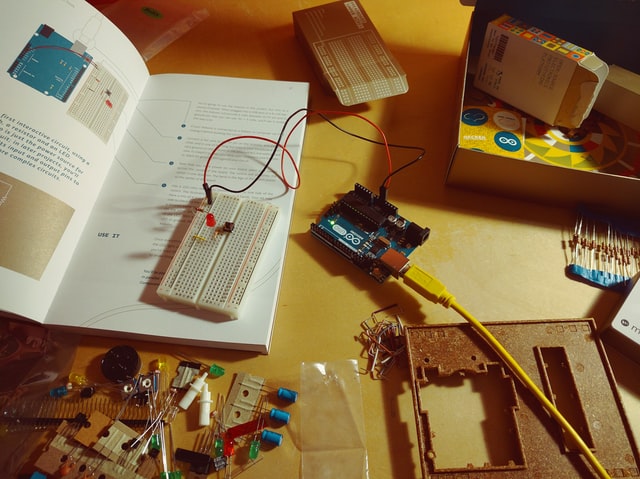In this age of information technology, kids have access to media where they can explore electronic gadgets from a young age. Enhancing their interests while they are at home is essential. One such fun activity can be making electronic gadgets at home. Being a parent, it is essential for you to motivate kids to develop an interest in such activities as electronics learning for kids at home. We are here to assist you by providing you with the proper guidance and support.
We understand that children need the opportunity to explore different gadgets and get experiences that can expand their learning horizon. This article will guide you on how to make electronic gadgets for kids at home.
How to Make Electronic Gadgets for Kids at Home?
Here are some interesting ideas for you. These ideas will assist you in enhancing the learning abilities of kids from the comfort of your home.
Paper Circuits
A paper circuit is an electronic circuit that is created on paper or cardboard with the materials like conductive copper tape, LED, and power sources like a coin-cell battery. Do not worry, your child is not at risk as these paper circuits are low-voltage electronic gadgets. Creating this gadget can help to teach the concepts of electricity and also the function of the circuit.

Steps to Create
# Separate copper tape
# Start at a battery location
# Connect the pieces of tape
# Begin at other location of the battery
# Connect the battery (One battery with the positive side and another one with the negative)
# Add the LED
# Complete the circuit and LED will be on
Colour Mixing LED Bracelet
An electronic gadget that can be prepared at home is a super-fun colour mixing bracelet. This bracelet is an introduction to the circuit’s techniques and material. To create these electronic gadgets for kids, the materials required are a conductive thread, CNC cut conductive plastic and resistive plastic which is called Velostat. Please follow the steps given below:
Steps to Follow
# If you want any picture on the bracelet, design it on the conductive fabric.
# Cut bracelet
# Cut conductive fabric
# Cut resistant plastic
# Prep and Sew LED
# Sew battery chip
# Sew resistive plastic
# Add battery and wear with different lights

Thermal Goggles
This is something kids will enjoy as they are interested in things that add up to their entertainment value. You can help your kids follow the following steps to make those awesome thermal goggles for your kids.
Steps to Follow
# Buy a pair of regular clear framed sunglasses.
# Remove the lenses and fix their shape into sheets of blue using red theatrical gels.
# Ensure that you have two pieces for each colour and try cutting it into 4 pieces using a knife.
# Make sure to put each colour gel on each lens of the glasses and wait for them to dry.
# Try fixing the 8 high-intensity infrared LEDs, 4 on each side, just outside the goggles.
# Secure the wires to the outer edge of the goggles using electrical tape.
# Try wiring the lights to the 3-volt, button cell battery and glue it to the side of the goggles.
# Make sure to test your goggles after you are done with the process.
Make A Battery with Spare Change
This is another homemade gadget for parents to work together with their kids. You need to simply follow the steps below.
Steps to Follow
# Pick up a calculator and try removing the screws on the back so that you have the battery. Pull the positive and negative leads and try attaching the terminals if you can.
# Pick up 3 coins and 3 zinc washers.
# Cut 3 round pieces of the cardboard and let them soak in white vinegar for 2 minutes.
# Try keeping a piece of aluminium foil on the battery cell, place 1 zinc washer in the end. Then, take cardboard, soak it in the vinegar, and dry it using a paper towel. Place it on the top of the washer.
# Last but not least, place the copper coin on the top of the cardboard and your battery is ready.
# The wires are then connected to the correct battery leads that were pulled out earlier. Once you press the “on” button the calculator will start working
# Try applying sandpaper to the copper coins.
# Try connecting the cells in the wires and put them on top of each other.
# Buy an LED to light up the long lead on the aluminium foil base.
Electronics Learning for Kids
Let’s look at some of the benefits of electronic gadget-making for kids at home.
Nurtures Creativity
Most parents find that their kids improve their level of creativity when making electronic gadgets. K-2 kids colour their picture by using a drawing sheet with the intention that LED light will be added to their picture which makes them feel better. For grades 3-5, kids draw pictures and cut them. The complexity level of the gadget making process can be increased based on the grade. This helps kids find new creative ways to solve problems.
Generate Awareness
Kids may find it difficult to learn in a conventional school environment, and this is where parents can help them through various learning activities at home. By making homemade gadgets, parents can make their kids aware of different technologies which they might find difficult to comprehend otherwise. Bringing in new projects like electronics for kids will help them understand new things they have never seen before and expand their learning horizon.
Brainstorming
Electronic gadgets making activities contribute to the brainstorming of the kids. Children develop an informal approach to solve the problem with their thinking process. They are encouraged to come up with different ideas to get the correct circuit formation and function. Such fun activities pique their interest. This sense of curiousness can invoke the feeling of solving a particular problem. This is when the child brainstorms to find different solutions to a problem.
Conclusion
Real School Of Montessori is all about bringing in a more wholesome and futuristic approach to learning. It is all about creating a concept of learning which is in sync with the fast-paced developments of the real world. It seeks to set the right curriculum where students can grow and learn while having fun. For more details, check out our website!







